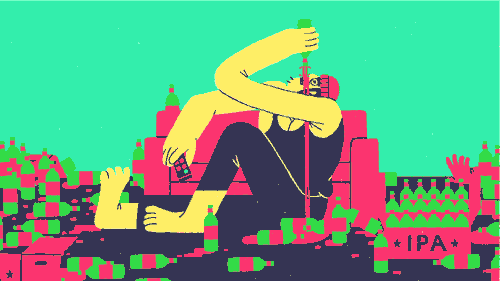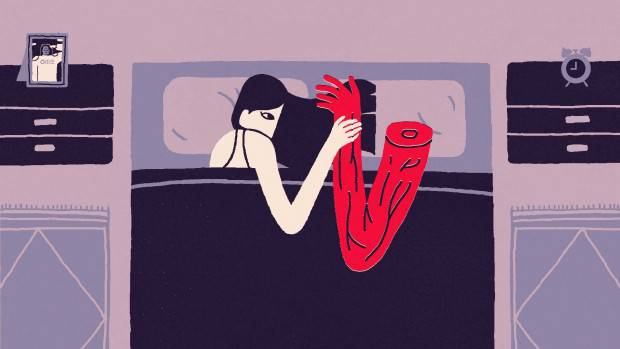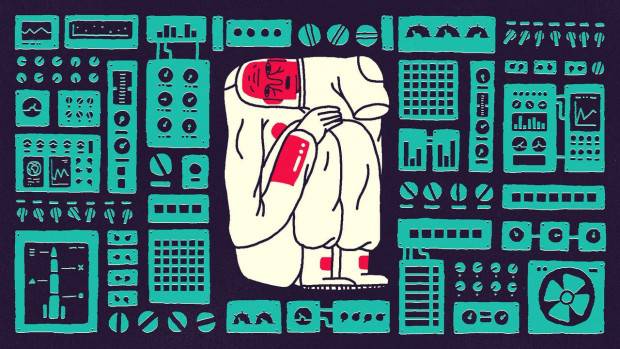Interview with ‘Loop Ring Chop Drink’ director Nicolas Ménard
UPDATE: Loop Ring Chop Drink recently picked up the Animated Grand Prix at this year’s Encounters Festival as well as the Award for Best Design and the Walt Disney Prize for Best Graduation Animation at the Ottawa International Animation Festival.
Graphic Artist and Animation Director Nicolas Ménard‘s most recent short film Loop Ring Chop Drink follows the seemingly unremarkable lives of four bizarre individuals who live in the same mundane apartment block. We follow the individuals as their lives are brought together in a series of surreal coincidences. The film showcases Ménard’s characteristic bold style, bringing together old school print graphics and seamless animation tell a hypnotic and bizarre tale.
Originally from Canada, Ménard currently lives in London after graduating from the RCA. During his career this talented animator has worked with dozens of clients including Google, la Cinémathèque Québécoise, Universal and Times magazine. He also works as a director at Nexus studios. We were able to ask a Nicolas a few questions and learn a little more about his work and where it came from.
The film was created as your RCA graduation film, where did the inspiration for the film come from?
Narratively, I would say I was inspired by a few authors I was reading at the time, like Etgar Keret and Jason. But my initial intention wasn’t to make a narrative film. The project was supposed to be a collection of catchy gags and surreal animations, but after some early comments from my friends and tutors, I felt pressured to craft a story out of all these bits of writing I was accumulating. I started to stitch them together and soon the story started to reveal itself. It was a counterintuitive way of working for me, but it was definitely an interesting experiment.
 You’ve managed to succeed in doing what many dream of doing when they start to study animation, developing an animation that keeps all the raw energy and vibrant colours of printmaking and translating it to a screen. What came first for you, printmaking or animation?
You’ve managed to succeed in doing what many dream of doing when they start to study animation, developing an animation that keeps all the raw energy and vibrant colours of printmaking and translating it to a screen. What came first for you, printmaking or animation?Printmaking came first, explaining my obsession for print aesthetics. I studied graphic design for 6 years in Montreal before my MA in Animation at the RCA. I used to do a lot of screen printing and experiments with my inkjet printer, and I wanted to merge these skills with my animation practice.
Colour is obviously very important in your work. Do you take a long time deliberating over what colour scheme to use or does it come more from wanting to set a certain type of mood in a film?
I have an odd relationship with colour. A very passionate and hateful relationship. I usually take forever to choose a colour palette for any kind project. If I do an illustration, I can make the drawing in a day or two and spend twice the amount of time figuring out the colours.
For Loop Ring Chop Drink, I chose a vibrant set of colours because I wanted a sunny Californian mood to contrast with the dark themes explored in the film. The palette changed a few times during production, but the rule was always to use “three inks”. Basically, the technique behind my RCA films is very similar to screen printing. In screen printing, if you have three inks, you can obtain additional colours by overlaying them.
I’m moving away from that approach nowadays, exploring new territories.
Where do you feel your bold, surreal approach to storytelling comes from?
A lot of my influences come from Japanese graphic arts and video games. I grew up with games like Super Mario Bros 3, which has a super playful but incredibly weird universe. Also, some games I grew up with had really low-fi and cold aesthetics because of the limitations at the time. I guess that left a strong impression on me. Stand-up comedy in general is also a big influence. The way Tig Notaro tells a story is very appealing to me, as well as Stewart Lee’s sarcasm and Louis C.K.’s dark comedy.
Being originally from Canada, what made you choose to come and study/work over here in England?
I just really wanted to study at the Royal College of Art! It was my dream school. I had this urge to make animated short films after my graphic design studies, and London seemed like a great starting point. Also, England is well known for its dynamic design culture and I wanted to dive into it.
I also wanted to ask about your work on the Google Play and California Sunday magazine project California Inspires Me. How were you approached and what were the parameters of the project?
The California Sunday Magazine wrote me an email. They introduced themselves as fans of my work and they wanted to work with me.
It’s always a pleasure when a new client wants to collaborate directly instead of going through a pitching process. And when they said it was for an animation on Jack Black, I jumped right in! After all, this is the closest I’ll ever get to Hollywood.The brief was to produce a 3m30s animation on an interview with Jack. I had 4 weeks to do the project, but I also had to do a print ad to promote the animation. Ii took much longer than I expected to get a sign off on the character design that would be the center piece of the print ad. When it came to start work on the animation, I only had 2 weeks left! I thought I would die but looks like I’m still here to talk about it.
What was it like to work with the voice of Jack Black, and the imagery he created with his memories?
It was brilliant. At first, I thought I would have a hard time adapting my visual universe around his stories, but it ended up being a pretty streamlined process. It was an absolute pleasure to animate on his voice, and it really made me appreciate the character. I’m a big Jack Black fan now.
You’re also involved with the Late Night Work Club, how were you introduced to that group?
It all started on the Twitter. It seems like most members have this fascinating habit of procrastinating on Twitter while doing indie animation. So they invited me to participate to the second volume. Now here I am, trying to figure out how to squeeze the production of a short film into my schedule.

Somewhere (Dir. Nicolas Ménard, 2013)
What has it been like to work alongside so many talented animators for LNWC – has it helped your own creative process at all?
The success of Volume 1 and the incredible talent of the other members is definitely putting a lot of pressure on me, which is necessary to complete a short film. Usually, you can find that kind of pressure in the context of a school project or a client project. So it’s nice to be in that position for a personal piece.
When did you first start working at Nexus and how would you describe your day-to-day role within the studio?
Upon graduating from the RCA in the summer of 2014, I signed a contract with Nexus Productions. Since then, I’ve been directing commercial projects under their banner. I share a studio space in their offices of Old Street with Jack Cunningham and Felix Massie. This is where I spend most of my time. I often have big gaps between projects, so I also have to focus on the illustration side of my career to make a living.
What’s your next project?
I finally completed my script for my Late Night Work Club short. The film is titled Looking for God and explores universal themes we all relate to such as faith, love, camping and the such. I’m starting production in October. Keep your eyes peeled for that one. Other projects include an interactive collaboration with Evan Boehm, and hopefully a video game next year.
Loop Ring Chop Drink will be screening at Bristol’s Encounters festival tomorrow within the Animation 1 screening Sensual Delights. You can book your tickets here.


